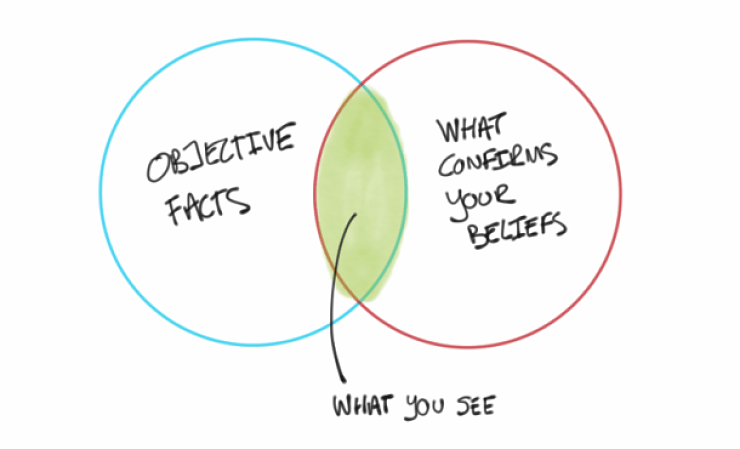Confirmation Bias Is a Helluva Drug

Intense political partisanship can lead to extraordinary cognition errors. It is therefore unsurprising that President Trump’s supporters see ballot-fraud conspiracies behind even the slightest voting irregularity, while every presidential tweet is taken for proof that the election is being stolen. For the most-avid MAGA enthusiasts, there is apparently no claim too wild to embrace, as confirmation bias does its inexorable work.
We expect to see confirmation bias play an active role in the politics, where there is a satisfying emotional payoff from assuming the worst of the other side. We do not expect the same phenomenon among highly educated professionals, especially in their seemingly well researched publications. But it turns out that even the most astute physicians, in the grip of motivated reasoning, may end up believing fantastical tales about lawyers and the legal system, so long as they confirm their assumptions about medical malpractice abuse.
Consider Dr. Paul Offit, a renowned academic pediatrician and vaccinologist, with a well-earned reputation as the scourge of scam artists, quacks, and dangerous frauds. His many outstanding books have exposed autism’s “false prophets,” the harms inherent in the anti-vaccine movement, and the dangers of taking advice from celebrities and politicians. In 2013, he won Robert P. Balles Prize in Critical Thinking from the Center for Skeptical Inquiry for Do You Believe in Magic?: The Sense and Nonsense of Alternative Medicine. There may be no doctor in America more identified with critical thinking than Paul Offit.
Nevertheless, Offit himself recently fell for a patently phony story about medical malpractice. In his latest book, Overkill: When Modern Medicine Goes Too Far, Offit recounts the shocking tale of a woman who obtained a $986,000 malpractice verdict for the loss of her alleged psychic powers. As Offit tells it, a plaintiff named Judith Haimes sued Temple University Hospital and her neurologist following a CT scan, claiming that her paranormal abilities had vanished and she could no longer “make a living by communicating with the dead.” Then,
On March 27, 1986, after deliberating for forty-five minutes, the eight-member jury awarded her $986,000. In order for jury members to have reached this verdict, they have to have agreed on three separate facts: one, that people have psychic powers to lose; two, that psychic powers can be lost in a CT scan; and three, that the neurologist should have known better than to have ordered a CT scan on a psychic.” (Offit 2020, pp. 211-12.)
This outrageous story reinforces Offit’s complaints about “today’s litigious climate” and the influence of the “plaintiff’s bar,” and his plea to eliminate “nonmedical juries,” but nearly everything he says is untrue.

Judith Haimes did file suit for the alleged loss of her psychic abilities (which did not include communicating with the dead) due to an adverse reaction to the dye injected before a CT scan. That claim, however, was dismissed by the trial judge, who told the jury to “disregard all evidence related to plaintiff’s loss of psychic powers.”
Instead, the jurors were specifically instructed to consider only “such physical pain, mental anguish, discomfort, inconvenience and distress as [Haimes] may have endured immediately and shortly after the dye was administered.” Her physical injury allegations were supported by the medical testimony of an otolaryngologist. The jury was never presented with any of the three propositions posed in Offit’s example.
Offit does report that the huge verdict was thrown out by the trial judge. Unmentioned in his book, however, is what the judge said concerning rumors about the case:
Many lobby groups, legislatures and government agencies perverted the facts of this case and the basis of the jury verdict and used it as an example of one of the causes of the alleged insurance crisis.
That was in 1986, on the first page of the opinion rejecting the verdict. It is remarkable that the “perverted” facts are still making the rounds among prominent and thoughtful physicians 34 years after they were identified and refuted in court. Offit’s misleading anecdote has already been recited least once, ironically by the aptly named “SkepDoc” in a post on the invaluable and widely read Science Based Medicine site.
I realized there was something fishy about the psychic story the moment I read it. The likelihood of a staggering verdict for the loss of psychic powers was about the same as the possibility of curing COVID-19 with a bleach injection. Offit’s own critical thinking, however, simply failed him when it came to lawyers and lawsuits, thus offering the nonsensical account in support of his plea to “eliminate jury trials.” That was the sort of motivated reasoning, or confirmation bias, that he has warned against throughout his exceptional career.
It was easy for me to find the true facts of the Haimes case once my mental alarm bell prompted me to look for it. Others have exposed similar tort stories as urban legends, some that are wildly spun out of real lawsuits, and some that are wholly imaginary. The distinguishing feature of these fables is that they have been eagerly accepted and repeated, no matter how far-fetched, so long as they reinforce preconceptions about law and justice.
The real Haimes case actually demonstrates that the legal system works pretty well. Judith Haimes experienced a serious adverse medical event, and she sincerely if mistakenly believed it had damaged the psychic powers from which she made a living. After she brought her complaint to court, the trial judge neatly separated her viable claim – for pain, nausea, vomiting, and seizures, purportedly caused by the dye injected for the CT scan – from her invalid one for damage to her psychic ability. The jury returned an excessive verdict, and the judge promptly threw it out. How else should a legal system work?
As the Haimes judge recognized, many bogus stories have been circulated by insurance lobbyists, who have an interest in discrediting personal injury litigation. I have great respect for Dr. Offit, and I read his work with much appreciation. But a skeptical physician should use his own well-tuned mental alarm bells to resist such spurious tort stories, rather than validate and spread them.



























































































